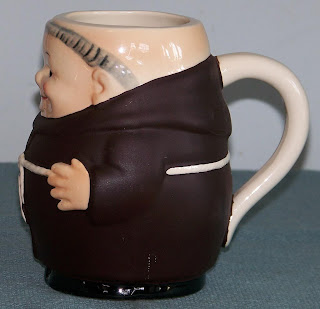The funeral yesterday of the late Cecilia Hara Kosaka (above, right) gave me an occasion to remember this wonderful couple; her and her late husband Manuel Borja Kosaka (left), who passed away many years ago. These two humble and devout Catholics were the parents of a Capuchin priest, Father Paulo Kosaka.
I didn't know Cecilia well, but her husband, Manuel, was the friary cook while I lived in it in the 1980s and into the early 90s, so I knew him much better. I saw him almost on a daily basis. He only had Saturdays completely off, and most of Sunday, coming in only to cook the Sunday evening meal.
Manuel had an interesting youth. He was born in Palau, of a Chamorro mother (Amalia Borja) and a Japanese father who became Catholic to marry Amalia, Paulus Kosaka.
Palau was part of the Japanese Mandated Pacific Islands when he was born in the 1920s. Palau had had a small community of Chamorro living there since Spanish times.
Manuel found himself stuck in Japan at the end of the war. If I recall correctly, he had no idea what became of his family in Palau because the war cut off all contact between him and them.
So he settled in Japan and, as one can see in the photo above, he became part of a small Japanese Catholic community. I believe that's him standing in the far right corner. The priest looks Caucasian. I believe the year this photo was taken is 1956.
He would have been married already to Cecilia, a full-blooded Japanese woman he met in Japan, by 1956. She's probably in the picture, too, but I can't tell which.
Eventually, Manuel made contact with his family, who had left Palau and settled on Guam, the homeland of the Borja family. They set up home in Talofofo. Their son, Paulo, grew up active in San Miguel parish and got to know the Capuchin friars who were the pastors. He eventually became a Capuchin himself.
Manuel would arrive at the friary around 10AM and he would always make his first stop the friary chapel and say a short prayer. He was dedicated to his job and cooked lunch and dinner for about 12 friars, many of them old and retired, and for about 30 friars, clergy and others on Thursday and Sunday nights when the bigger community gathered.
He was soft-spoken and spoke only when necessary. He spoke basic English, but he was one of the first with whom I was able to start practicing my Chamorro. He spoke Chamorro and his Japanese was even better. I was always fascinated to catch him and Father Ferdinand Pangelinan, a Chamorro friar from Saipan who spoke good Japanese, speaking in that language. Father Ferdinand had been in a seminary in Tokyo during the war.
Once in a while he would say something to encourage our vocations (we, the young ones just entering religious life).
I once learned a neat trick from Manuel; how to kill a snake in a bloodless way. We found a snake in our chapel and told him about it. He filled a bucket with soapy water and took a broom to the chapel. He let the snake curl onto the broom stick, then he shook the snake into the soapy water and then - well, it was "rest in peace" for the dead, but clean, snake.
| Father Paulo accompanied his mother to visit her relatives in Japan some years ago. |
As he got older, Manuel started to show more signs of fatigue. He would take breaks, sitting outside on the top of a rather long cement staircase. When the superior saw this, he had us make up a guest room for Manuel which he could use anytime he needed a break. Manuel used it once. He didn't feel comfortable being given that opportunity to have his own room in the friary, even in the guest quarters. He went back to dozing off a little on his short breaks, sitting outside on the top of the stairs.
I finally had my one and only chance to do something for Manuel, who worked so hard for us. A Japanese teacher at the same school I taught at learned I liked old Japanese songs; songs from the 1940s and 50s. My mother had taught me a Japanese song she learned during the war.
So this Japanese lady gave me the present of a cassette tape of these types of Japanese oldies. I played it for Manuel, asking him to tell me the Japanese words so I could learn to sing them. But then he asked me to make him a copy of the tape. These were the songs he heard in Japan when he lived there in the 40s and 50s but probably hadn't heard since then. I made him a copy and he would play it at home, where Cecilia certainly heard them, too.
Cecilia, I didn't know too well, but she was also a worker in the cooking department, but for Notre Dame High School. She made the best sushi, so they tell me. She lived much longer than her husband and suffered very poor health in the last year or so. She would go into a coma. They thought the time had come. Then she'd revive. Father Paulo said in his sermon that they started to call her Lazarus, as she seemed to come back to life every time the end seemed imminent. But last week the Lord finally called her and her battle was over.
May she and Manuel come at last to the place of eternal joy. They were simple, humble and hard-working people, believers in the Lord and His Church. I think the Lord finally has for Manuel that room to rest in up in heaven, instead of that guest room that he didn't feel worthy of, even in our friary.
















